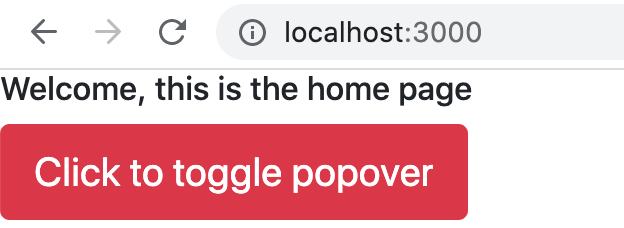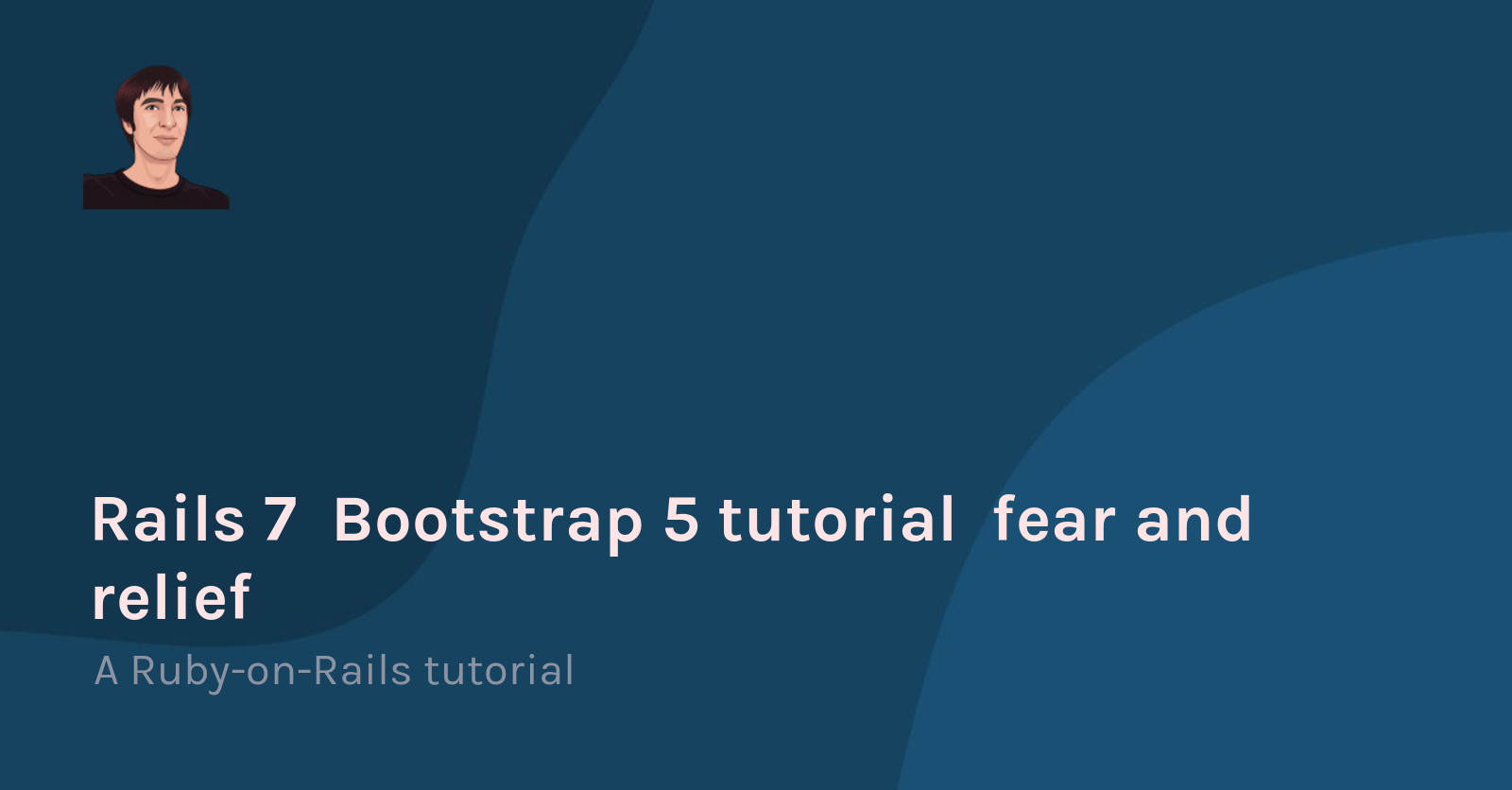Rails 7, Bootstrap 5 tutorial, fear and relief
0. A big warning
At BootrAils, we are very excited that Rails 7 is out since mid-december, 2021. The frontend assets management is once again completely different. Rails 6 almost dropped Sprockets in favor of Webpack - see this article, now Rails 7 almost dropped Webpack in favor of jsbundling-rails (with esbuild) + import maps + Sprockets.
So we, as Rails developers, have choices. For this tutorial, we will use the default Rails 7 options - but we are not sure you should. That’s the fear. Relief will be for the end of the article.
If you want a full setup of Bootstrap 5 with Webpacker, see that other article.
1. Prerequisites
Check that you have ruby 3 already installed. Check you also have bundler installed, and npm above version 7
1
2
3
4
5
6
7
8
9
10
$> ruby -v
ruby 3.0.0p0 // you need at least version 3 here
$> bundle -v
Bundler version 2.2.11
$> npm -v
8.3.0 // you need at least version 7.1 here
$> yarn -v
1.22.10
$> psql --version
psql (PostgreSQL) 13.1 // let's use a production-ready database locally
Any upper versions should work.
2. Create an isolated, new Rails 7 app
1
2
3
4
5
$> mkdir myapp && cd myapp
$/myapp> echo "source 'https://rubygems.org'" > Gemfile
$/myapp> echo "gem 'rails', '7.0.0'" >> Gemfile
$/myapp> bundle install
$/myapp> bundle exec rails new . --force --css=bootstrap -d=postgresql
Open Gemfile, and replace line
1
gem "turbo-rails"
by
1
gem "turbo-rails", '~> 1.0.0'
This step is a buggy behaviour, due to the fact that Rails 7 is quite new as the time of writing.
Continue inside bash :
1
2
3
$/myapp> bundle update
$/myapp> bin/rails db:create
$/myapp> bin/rails db:migrate
3. Is Bootstrap v5 already installed ? a check
In this paragraph, we will not write any code, instead, we will read what is already installed for us.
Some good news : maybe you noticed the --css=bootstrap option above. This means the last Bootstrap version is already installed.
Let’s check where this happens :
package.json
1
2
3
4
5
6
7
8
9
10
11
12
13
// inside package.json
{
"name": "app",
"private": "true",
"dependencies": {
"@hotwired/stimulus": "^3.0.1",
"@hotwired/turbo-rails": "^7.1.0",
"@popperjs/core": "^2.11.0",
"bootstrap": "^5.1.3",
"esbuild": "^0.14.5",
"sass": "^1.45.0"
}
}
Ok ! Bootstrap 5 and its dependencies is properly installed inside package.json
1
2
// inside app/assets/stylesheets/application.bootstrap.scss
@import 'bootstrap/scss/bootstrap';
Great ! Standard import of bootstrap scss source, this will allow us fine tuning later.
1
2
3
4
5
// inside app/javascript/application.js
// Entry point for the build script in your package.json
import "@hotwired/turbo-rails"
import "./controllers"
import * as bootstrap from "bootstrap"
Ok ! JavaScript for Bootstrap is now loaded - even if no initialisation happens so far.
Open app/views/layouts/application.html.erb
1
2
3
4
5
6
7
8
9
10
11
12
13
14
15
16
<!DOCTYPE html>
<html>
<head>
<title>Myapp</title>
<meta name="viewport" content="width=device-width,initial-scale=1">
<%= csrf_meta_tags %>
<%= csp_meta_tag %>
<%= stylesheet_link_tag "application", "data-turbo-track": "reload" %>
<%= javascript_include_tag "application", "data-turbo-track": "reload", defer: true %>
</head>
<body>
<%= yield %>
</body>
</html>
The interesting lines are javascript_include_tagand stylesheet_link_tag. They allow us to profit from initial SCSS and JS files in each template that inherits from the default layout.
Create bare minimal Bootstrap 5 HTML
Create a controller :
1
2
3
# inside app/controllers/home_controller.rb
class HomeController < ApplicationController
end
Configure a default route :
1
2
3
4
5
# inside config/routes.rb
Rails.application.routes.draw do
get "home/index"
root to: "home#index"
end
Now create a view tailored for Bootstrap 5 : just copy/paste the code below into app/views/home/index.html.erb
1
2
3
4
5
6
7
8
9
10
<!-- inside app/views/home/index.html.erb -->
<h1>Welcome, this is the home page</h1>
<button type="button"
class="btn btn-lg btn-danger"
data-bs-toggle="popover"
title="Popover title"
data-bs-content="Amazing content, right ?">
Click to toggle popover
</button>
This HTML should show a popover when clicking the red button, only if
- Bootstrap CSS is properly configured,
- Bootstrap JS is loaded and initialized.
Great ! This bare minimalistic example will ensure everything works properly.
Bootstrap 5, Rails 7, locally : let’s start !
1
2
3
4
5
6
7
8
9
10
11
12
13
14
15
16
17
18
19
20
21
22
23
24
$/myapp> ./bin/dev
17:24:24 web.1 | started with pid 26889
17:24:24 js.1 | started with pid 26890
17:24:24 css.1 | started with pid 26891
17:24:24 css.1 | yarn run v1.22.10
17:24:24 js.1 | yarn run v1.22.10
17:24:24 css.1 | $ sass ./app/assets/stylesheets/application.bootstrap.scss ./app/assets/builds/application.css --no-source-map --load-path=node_modules --watch
17:24:24 js.1 | $ esbuild app/javascript/*.* --bundle --sourcemap --outdir=app/assets/builds --watch
17:24:25 js.1 | [watch] build finished, watching for changes...
17:24:25 css.1 | Sass is watching for changes. Press Ctrl-C to stop.
17:24:25 css.1 |
17:24:26 web.1 | => Booting Puma
17:24:26 web.1 | => Rails 7.0.0 application starting in development
17:24:26 web.1 | => Run `bin/rails server --help` for more startup options
17:24:26 web.1 | Puma starting in single mode...
17:24:26 web.1 | * Puma version: 5.5.2 (ruby 3.0.0-p0) ("Zawgyi")
17:24:26 web.1 | * Min threads: 5
17:24:26 web.1 | * Max threads: 5
17:24:26 web.1 | * Environment: development
17:24:26 web.1 | * PID: 26889
17:24:26 web.1 | * Listening on http://127.0.0.1:3000
17:24:26 web.1 | * Listening on http://[::1]:3000
17:24:26 web.1 | Use Ctrl-C to stop
Great ! the console indicates that we should go to localhost:3000 to see what is happening. Let’s go :

Try to click the button. Nothing happens.
Adding custom Bootstrap-based JavaScript into Rails
Let’s follow the Bootstrap docs here :
https://getbootstrap.com/docs/5.1/components/popovers/#example-enable-popovers-everywhere
And inject it into Rails
1
2
3
4
5
6
7
8
9
// Inside app/javascript/application.js
import "@hotwired/turbo-rails"
import "./controllers"
import * as bootstrap from "bootstrap"
let popoverTriggerList = [].slice.call(document.querySelectorAll('[data-bs-toggle="popover"]'))
let popoverList = popoverTriggerList.map(function (popoverTriggerEl) {
return new bootstrap.Popover(popoverTriggerEl)
})
Now reload your browser, and click the big red button

Great ! it works
Add custom SCSS
1
2
3
// inside app/assets/stylesheets/application.bootstrap.scss
$h1-font-size: 1rem; // this line was added
@import 'bootstrap/scss/bootstrap';
Reload your browser

Rails 7 and Bootstrap 5 are now going to production : deploy to Heroku
1
2
3
4
5
6
7
8
9
$/myapp> heroku login
$/myapp> heroku create
$/myapp> echo "web: bundle exec puma -C config/puma.rb" >> Procfile
$/myapp> bundle lock --add-platform x86_64-linux
$/myapp> heroku addons:create heroku-postgresql:hobby-dev
$/myapp> heroku buildpacks:add heroku/ruby
$/myapp> heroku buildpacks:add heroku/nodejs
$/myapp> git add . && git commit -m 'ready for prod'
$/myapp> git push heroku main
The buildpacks are adding an environment to your production machine. The flag –add-platform x86_64-linux is here for compatibility reasons with Heroku. Apart from these, each command above is pretty verbose, you won’t be lost.
Installation will last 1 or 2 minutes. You should see the URL where your production-ready app is deployed at the bottom of your terminal. But wait a minute before opening it.
Enter :
1
$/myapp> heroku run rails db:migrate
Now open your browser (not localhost, but the production URL provided by Heroku). You should see the title and button, and if you click the button… What happened ;) ?
A relief, yet to be improved
The relief is that compared to the previous blog article with the webpacker settings, Bootstrap 5 almost works out-of-the-box with Rails 7. However, the number of tools to achieve the result is not entirely satisfying. We’ll give explanations next week :)
Stay tuned !
